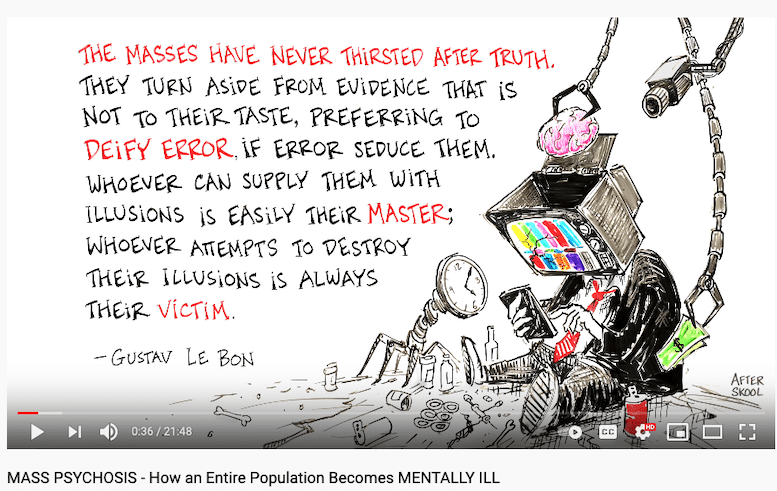The 20-minute video above, “Mass Psychosis — How an Entire Population Becomes Mentally Ill,” created by After Skool and Academy of Ideas,1 is a fascinating illustration of how mass psychosis can be induced.
Mass psychosis is defined as “an epidemic of madness” that occurs when a “large portion of society loses touch with reality and descends into delusions.”
One classic historical example of mass psychosis is the witch hunts that occurred in the Americas and Europe during the 16th and 17th centuries, when tens of thousands of people, mostly women, were tortured, drowned and burned alive at the stake. The rise of totalitarianism in the 20th century is a more recent example of mass psychosis.
Man’s Worst Enemy
As noted in the video:
“The masses have never thirsted after truth. They turn aside from evidence that is not to their taste, preferring to deify error, if error seduce them. Whoever can supply them with illusions is easily their master; whoever attempts to destroy their illusions is always their victim.”
That’s a quote attributed to Gustave Le Bon, a French social psychologist renowned for his study of crowds. His book, “The Crowd: A Study of the Popular Mind,”2 takes a deep dive into the characteristics of human crowds and how, when gathered in groups, people tend to relinquish conscious deliberation in favor of unconscious crowd action. Similarly, psychologist Carl Jung once stated that:
“It is not famine, not earthquakes, not microbes, not cancer, but man himself who is man’s greatest danger to man, for the simple reason that there is no adequate protection against psychic epidemics, which are infinitely more devastating than the worst of natural catastrophes.”
When a society descends into madness, the results are always devastating. Jung, who studied mass psychoses, wrote that the individuals who make up the affected society “become morally and spiritually inferior.” They become “unreasonable, irresponsible, emotional, erratic and unreliable.”
Worst of all, a psychotic mob will engage in atrocities that any solitary individual within the group would normally never consider. Yet through it all, those affected remain unaware of their condition and cannot recognize the error in their ways.
What Causes Mass Psychosis?
To understand how an entire society can be driven to madness, you must first understand what drives any given individual to insanity. Barring drug or alcohol abuse, or a brain injury, psychosis is typically triggered by psychogenic factors, i.e., influences that originate in the mind.
One of the most common psychogenic factors that can trigger psychosis is a flood of negative emotions such as fear or anxiety that drives the person into a state of panic. When in a panic, the natural inclination is to seek relief. A psychologically resilient individual may adapt by facing their fear and ultimately defeating it.
Another coping mechanism is a psychotic break. As explained in the video, a psychotic break is not the descent into chaos, but rather a reordering of one’s experiential world in a way that blends fact and fiction, reality and illusions, in such a way that a sense of control is restored and panic ends. The psychogenic steps that lead to madness can be summarized as follows:
- Phase of panic — Here, the individual begins to perceive the world around him or her in a different way and is frightened on account of it. There’s a perceived threat, whether it be real, fabricated or imagined. Confusion grows as they can’t find a way to rationally explain the strange occurrences taking place around them.
- Phase of psychotic insight — Here, the individual manages to explain his abnormal experience of the world by inventing an illogical but magical way of seeing reality. The term “insight” is used, because the magical thinking allows the individual to escape from the panic and find meaning again. However, the insight is psychotic, because it’s based on delusions.
Just as a psychologically weak and vulnerable individual can be driven to madness, so can large groups of weak and vulnerable people descend into madness and magical thinking.
Totalitarianism Is a Society Built on Delusions
In the 20th century, we’ve seen a rise in totalitarianism, defined by professor and religious studies scholar Arthur Versluis as:
“The modern phenomenn of total centralized state power coupled with the obliteration of individual human rights: In the totalized state, there are those in power and there are the objectified masses, the victims.”
In a totalitarian society, there are two classes: the rulers and the ruled, and both groups undergo a pathological transformation. Rulers are raised to a god-like status where they can do no wrong — a view that easily leads to corruption and unethical behavior — while the ruled are transformed into dependent subjects, which leads to psychological regression.
Joost Meerloo, author of “Rape of the Mind,” compares the reactions of citizens living in totalitarian states to that of schizophrenics. Both rulers and the ruled are ill. Both live in a delusional fog, as the entire society and its rules are sustained by delusional thinking.
As noted in the video, only deluded people regress to a child-like state of total submissiveness, and only a deluded ruling class will believe they possess the knowledge and wisdom to control society in a top-down manner. And, only a deluded person will believe that a power-hungry elite ruling a mentally regressed society will result in anything but mass suffering and financial ruin.
The mass psychosis that is totalitarianism begins within the ruling class, as the individuals within this class are easily enamored with delusions that augment their power. And no delusion is greater than the delusion that they can, and should — indeed are destined to — control and dominate all others.
Whether the totalitarian mindset takes the form of communism, fascism or technocracy, a ruling elite that has succumbed to their own delusions of grandeur then sets about to indoctrinate the masses into their own twisted worldview. All that’s needed to accomplish that reorganization of society is the manipulation of collective feelings.
Killing of the Mind
Menticide is a term that means “killing of the mind,” and it’s an ancient way of controlling the masses by systematically killing the human spirit and free thought. It’s a system through which the ruling elite imprints their own delusional worldview onto society.
A society is primed for menticide by the intentional sowing of fear. A particularly effective way to induce fear and panic that results in psychosis is the unleashing of waves of terror, and it doesn’t matter if the “terror” in question is real or fictitious. The waves of terror technique can be graphed out as an escalating wave pattern where each round of fear is followed by a round of calm.
After a short period of calm, the threat level is elevated again, with each round of fearmongering being more intense than the one before. Propaganda — fake and misleading news — are used to break down the minds of the masses, and over time, it becomes easier and easier to control everyone as confusion and anxiety give way to the magical thinking and psychotic insight presented as solutions through the media.
Contradictory reports, nonsensical recommendations and blatant lies are deployed intentionally, as it heightens confusion. The more confused a population is, the greater the state of anxiety, which reduces society’s ability to cope with the crisis. As the ability to cope withers, the greater the chances a mass psychosis will develop.
As noted in the video, “Confusion heightens the susceptibility of a descent into the delusions of totalitarianism.” Or, as Meerloo noted in his book:
“Logic can be met with logic, while illogic cannot. It confuses those who think straight. The big lie and monotonously repeated nonsense have more of an emotional appeal … than logic and reason. While the people are still searching for a reasonable counterargument to the first lie, the totalitarians can assault them with another.”
The Rise of Technocracy
What sets modern-day totalitarianism apart from previous totalitarian states is technology. The means to incite fear and manipulate people’s thinking has never been more efficient or effective. TV, internet, smartphones and social media are all sources of information these days, and it’s easier than ever to control the flow of that information.
Algorithms automatically filter out the voices of reason and rational thinking, supplanting them with fear narratives instead. Modern technologies also have addictive qualities, so many voluntarily expose themselves to the brainwashing. Commenting on man’s reliance on technology, Meerloo notes:
“No rest, no meditation, no reflection, no conversation. The senses are continually overloaded with stimuli. Man doesn’t learn to question his world anymore. The screen offers him answers already made.”
Isolation — A Mass Psychosis-Inducing Tool
Aside from the onslaught of fearmongering and false propaganda, the ultimate tool to induce psychosis is isolation. When you are deprived of regular social interactions and discussions, you become more susceptible to delusions for a number of reasons:
- You lose contact with corrective forces of positive examples, role models of rational thinking and behavior. Not everyone is tricked by the brainwashing attempts of the ruling elite, and these people can help free others from their delusions. When you’re in isolation, the power of these individuals greatly diminishes.
- Like animals, human behavior is significantly easier to manipulate when the individual is kept in isolation. As animal research has discovered, conditioned reflexes are most easily developed in a quiet, secluded laboratory with a minimum of stimuli to detract from the indoctrination.
When you want to tame a wild animal, you must isolate the animal and patiently repeat a particular stimulus until the desired response is obtained. Humans can be conditioned in the same manner. Alone, confused, and battered by waves of terror, a society kept in isolation from each other descends into madness as rational thought is obliterated and replaced with magical thinking.
Once a society is firmly in the grip of mass psychosis, totalitarians are free to take the last, decisive step: They can offer a way out; a return to order. The price is your freedom. You must cede control of all aspects of your life to the rulers, because unless they are granted total control, they won’t be able to create the order everyone craves.
This order, however, is a pathological one, devoid of all humanity. It eliminates the spontaneity that brings joy and creativity to one’s life by demanding strict conformity and blind obedience.
And despite the promise of safety, a totalitarian society is inherently fearful. It was built on fear, and is maintained by it too. So, giving up your freedom for safety and a sense of order will only lead to more of the same fear and anxiety that allowed the totalitarians to gain control in the first place.
How Can Mass Psychosis Be Reversed?
Can totalitarianism be prevented? And can the effects of mass psychosis be reversed? Yes, but just as the menticidal approach is multipronged, so must the solution be. To help return sanity to an insane world, first you need to center yourself and live in such a way as to provide inspiration for others to follow. As noted by Jung:
“It is not for nothing that our age cries out for the redeemer personality, for the one who can emancipate himself from the grip of the collective psychosis and save at least his own soul, who lights a beacon of hope for others, proclaiming that here is at least one man who has succeeded in extricating himself from the fatal identity with the group psyche.”
Next, you need to share and spread the truth — the counternarrative to the propaganda — as far and wide as possible. Because truth is always more potent than lies, the success of propaganda relies on the censoring of truth. Another tactic is to use humor and ridicule to delegitimize the ruling elite.
A strategy proposed by Vaclav Havel, a political dissident who became the president of Czechoslovakia, is called “parallel structures.” A parallel structure is any kind of business, organization, technology, movement or creative pursuit that fits within a totalitarian society while being morally outside of it.
Once enough parallel structures are created, a parallel culture is born that functions as a sanctuary of sanity within the totalitarian world. Havel explains this strategy in his book, “The Power of the Powerless.”
Last but not least, to prevent the descent into totalitarian madness, sane and rational action must be taken by as many people as possible. The totalitarian elite do not sit around twiddling their thumbs, hoping and wishing to increase their power and control. No. They are actively taking steps to augment their position. To defend against them, the would-be-ruled must be just as active and resolute in their counter-push toward freedom.
All of this can be extremely challenging as people around you succumb to collective psychosis. But as Thomas Paine once said:
“Tyranny, like hell, is not easily conquered, yet we have this consolation with us, that the harder the conflict, the more glorious the triumph.”



















